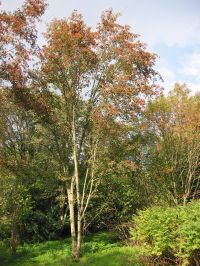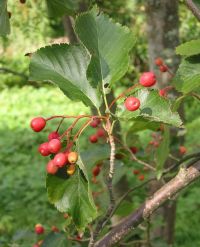Korean Mountain ash, Alder-leafed Whitebeam - Sorbus_alnifolia
English name:
Korean Mountain ash, Alder-leafed Whitebeam
Scientific name:
Sorbus alnifolia
Family:
Rosaceae (Rose)
Height:
9 M in Hørsholm
Flowering:
mid May to early June
Range:
China, Korea, Japan
 |
|
 |
 |
The Sorbus alnifolia in the upper picture is from seed collected by the Nordic Arboretum Committee expedition to South Korea in 1976. The seed was collected on Mt. Sogri San in Chungcheong Province. Three examples can be found in square 1112 positions 117 to 418 growing near the Lake road (Søvejen) a bit east of a Sorbus torminalis with a bright yellow medicine-plant sign. A map with squares and positions can be found on our homepage under: Plant search.
Plant description:
The genus Sorbus has is naturally widespread in the northern hemisphere. The genus Sorbus is reported to have 193 species. It is a large diverse genus and is subdivided into 5 subgenera. Two contain many species (subgenera Sorbus and Aria) while the remaining three are represented by only one species each. We have 56 species of Sorbus registered as growing at Hørsholm and have representatives of all 5 subgenera in our collection. There are 15 specimens of Sorbus alnifolia representing 6 different wild-grown provenances in Japan, Korea and China. This months plant belongs to the subgenus Aria, and thus it lacks compound leaves.
The species name alnifolia refers to the shape of the leaves, which remind on of alder tree leaves.
Sorbus alnifolia was introduced into European cultivation by the German nurseryman Späth in 1892. It is first registered in Denmark at the Forest Botanic Garden in Charlottenlund in 1921. This specimen is still alive. Sorbus alnifolia was also registered at the Copenhagen Botanic Garden in 1930. Our oldest plants in Hørsholm date from 1977 and were collected in the Nordic Arboretum Committee Expeditions to Japan and Korea in 1976. There are considerable differences in growth in our specimens, the tallest which are 9 to 10 m in height are from the Daisen Volcano on Honshu, Japan. The shortest are only about 3 m in height but only 4 years younger. They come from Gyeonggi Privince in South Korea.
The wood is used for furniture making and the bark for dye making in Japan. It has been used to make rulers in Russia. It has great potential as an ornamental plant.
These are small to medium sized deciduous trees with a crown that cast dense shade. Some provenances will reach perhaps 15 m in height Denmark. The species has a wide distribution in the cool temperate zones of Japan, Korea and Eastern China and is variable in growth rate, fruit colour and leaf shape. The bark is grey and smooth. In the large tree in Forest Botanic Garden it resembles beech bark in colour and form. The leaves are arranged alternately on the shoots. They are ovate with rounded or acute teeth on the margin. The leaf base is rounded and the tip pointed. Leaf size varies among the provenances. The upper surface of the leaf is deep mat green with impressed veins while the lower surface is lighter green with prominent protruding veins. The leaf petiole is grooved on top. In the autumn the leaves are yellow, orange or copper in colour. The flowers are in flattened clusters at the end of the shoots and white. The fruits are rounded or somewhat broader towards the tip. They ripen to varying degrees of red depending on the individual tree. The fruit has distinct lenticels of varying density. The fruits may be small and sterile if only one clone is grown as they are not self-fertile.
Sorbus alnifolia forms dense, small- to medium-sized trees with striking fruit which last until early winter and attractive autumn colours. Often it is described as an uncommon tree despite significant merit as a garden ornamental. It is easy to transplant but it is susceptible to air pollution and so is not recommended as a street tree. It is the only Sorbus species described in the book Plants that merit attention- Trees, reflecting its potential but underutilization. The arboretum has sent specimens for trial at a number of other parks and gardens including: Aalholm Park, Vilvorde Havebrugsskole, Sorø Akademihave, Gunderslevholm Park, Den Geografiske have, Blågård Seminarium and Bangsbo Botaniskhave.
References:
Bean, W.J. 1980 Trees and Shrubs Hardy in the British Isles Vol IV A-C Eight edition. John Murray publishers. 808 pp.
Kurata, Satoru. 1971. Illustrated Important Forest Trees of Japan Vol 1. (2nd edition) Chikyusha Co. Ltd. Tokyo. 265 pp.
Lange, J. 1999. Kulturplanternes Indførselshistorie i Danmark indtil midten af 1900-talet. (Introduction History of Cultivated Plants in Denmark up to the middle of the 20th century). DSR Forlag, Frederiksberg C. 458 pp.
Mabberley, D.J. 1998. The Plant Book. The Bath Press, Bath, 858 pp.
Olsen, O. et al. 1997 Havens Planteleksikon. Træer og Buske. (Danish Plant Encyclopedia, Trees & Bushes). Det Danske Haveselskab Publisher, 674 pp.
Poor, J.M. & Brewster, N.P. 1994. Plants that merit attention. I. Trees. Timber Press Inc. Portland.
Rushforth, K. 1999. Trees of Britain and Europe. Harper Collins Publisher. 1336 Pp.
